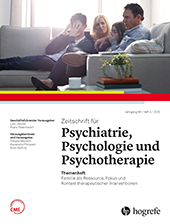Abstract
Zusammenfassung. Die Familie spielt für die körperliche und psychische Gesundheit eine wichtige Rolle. Familienbeziehungen können die Ursache psychischer Probleme sein oder psychische Probleme verstärken. Sie können aber auch eine wichtige Ressource zur Bewältigung psychischer Probleme sein. Andererseits kann eine akute oder chronische psychische Belastung auch Probleme in Familienbeziehungen verursachen oder verstärken. Der Familienkontext bietet deshalb verschiedenste Ansatzpunkte für therapeutische Interventionen. Die vorliegende Auswahl wissenschaftlicher Beiträge beleuchtet unterschiedliche Facetten von Partnerschaft und Familie sowie deren Relevanz für die Psychotherapie und psychologische Interventionen. Sie umfasst einerseits unmittelbare Interventionsforschung auf Paar- und auf Familienebene, andererseits aber auch die Erforschung von Interaktionsprozessen von Paar- und Eltern-Kind Beziehungen, die Untersuchung des Interventions- und Unterstützungsbedarfs von Müttern von Kleinkindern sowie Forschung zur Ressourcenfunktion der Familie im Kontext einer chronischen Krankheit. Die Beiträge unterstreichen auf vielfältige Weise wie eng verwoben das individuelle und das interpersonelle Funktionsniveau auf Familien- und Paarebene sind und wie therapeutische Interventionen vom Einbezug familiärer oder partnerschaftlicher Prozesse profitieren können.
Abstract. The family plays an important role in physical and mental health. Family relationships can cause or exacerbate mental-health problems, but they can also be an important resource for coping with mental-health problems. Likewise, acute or chronic mental stress can also cause or exacerbate problems in family relationships. The family context therefore offers various starting points for initiating therapeutic interventions. The present collection of scientific contributions illuminates different facets of family and couple relationships as well as their relevance for psychotherapy and psychological interventions. This includes direct intervention research at the couple and family level and research on interaction processes of couple and parent-child relationships, the investigation of the intervention and support needs of mothers of young children, as well as research on the resource function of the family in the context of a chronic disease. These contributions underline how closely interwoven the individual and interpersonal levels of psychological functioning at the family and couple level are, and how therapeutic interventions may benefit from incorporating aspects of the family or couple relationship.
Literatur
(2009). The relationship between child abuse, parental divorce, and lifetime mental disorders and suicidality in a nationally representative adult sample. Child Abuse & Neglect , 33 , 139–147.
(1995). Parental divorce, marital conflict, and offspring well-being during early adulthood. Social Forces , 73 , 895–915.
(2003).
Prävention bei Paaren und Familien . In M. Jerusalem H. Weber (Hrsg.). Psychologische Gesundheitsförderung – Diagnostik und Prävention (S.445–460). Göttingen: Hogrefe.(2020). Messung der Stimmfrequenz im Paargespräch – Chancen für Diagnostik und Intervention in der Paartherapie. Zeitschrift für Psychiatrie, Psychologie und Psychotherapie , 68 , 217–227.
(2003). Intergenerational transmission of partner violence: A 20-year prospective study. Journal of Consulting and Clinical Psychology , 71 , 741–753.
(2020). Paarbasierte Psychotherapie: Ein Review der Wirksamkeit kognitiv-verhaltenstherapeutischer Ansätze mit Paaren bei psychischen Störungen. Zeitschrift für Psychiatrie, Psychologie und Psychotherapie , 68 , 207–216.
(1999). What predicts change in marital interaction over time? A study of alternative models. Family Process , 38 , 143–158.
(2020). Gottmans Balance-Theorie im Kontext von Eltern-Kind-Beziehungen. Zeitschrift für Psychiatrie, Psychologie und Psychotherapie , 68 , 229–242.
(2002). Prävention kindlicher Verhaltensstörungen. Psychologische Rundschau , 53 , 170–183.
(2007). Expressed Emotion and Relapse of Psychopathology. Annual Review of Clinical Psychology , 3 , 329–352.
(2020). Familienaufstellung als Einzelintervention im Gruppensetting bei chronisch-psychosozialen Konflikten: kurz-, mittel- und langfristige Wirksamkeit. Zeitschrift für Psychiatrie, Psychologie und Psychotherapie , 68 , 263–273. (2017). Zooming in: A microanalysis of couples' dyadic coping conversations after experimentally induced stress. Journal of Family Psychology , 31 , 1063–1073.
(2013). Stress processes in families and couples. In G. W. Peterson & K. R. Bush (Eds.) Handbook of marriage and the family (pp.159–176). Boston: Springer.
(2020). Familienzeit als Schutzfaktor für emotionale Probleme und Verhaltensprobleme von Kindern und Jugendlichen mit Diabetes mellitus Typ I. Zeitschrift für Psychiatrie, Psychologie und Psychotherapie , 68 , 252–262.
(2007). Familiale Kontexte und sozial-emotionale Entwicklung. Kindheit und Entwicklung , 16 , 199–208.
(2002). Risky families: family social environments and the mental and physical health of offspring. Psychological Bulletin , 128 , 330–366.
(2011). Divorce and death: A meta-analysis and research agenda for clinical, social, and health psychology. Perspectives on Psychological Science , 6 , 454–474.
(1999). Die Nachscheidungsfamilie sechs Jahre nach der elterlichen Trennung. Zeitschrift für Familienforschung , 11 , 28–55.
(2020). Wissen und Handeln – Erziehungsbedarf von Müttern mit Kleinkindern: Eine qualitative Untersuchung. Zeitschrift für Psychiatrie, Psychologie und Psychotherapie , 68 , 243–251.
(2017). Protective processes underlying the links between marital quality and physical health. Current Opinion in Psychology , 13 , 148–152.
(2011). Early adversity and adult health outcomes. Development and Psychopathology , 23 , 939–954.
(2016). The long reach of nurturing family environments: Links with midlife emotion-regulatory styles and late-life security in intimate relationships. Psychological Science , 27 , 1443–1450.
(2011). Job stress and family social behavior: the moderating role of neuroticism. Journal of Occupational Health Psychology , 16 , 441–456.
(2013). Fundamental frequency during couple conflict: An analysis of physiological, behavioral, and sex-linked information encoded in vocal expression. Journal of Family Psychology , 27 , 212–220.



